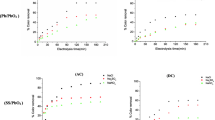Abstract
The electrochemical performance of SnO2 as an anode material with high oxygen gas-evolution overpotential was investigated in view of its application for electrochemical oxidation of bio-refractory organics in waste waters. The influence of the doping agent (Sb, F, Cl) and doping level on the oxygen-evolution reaction was studied in terms of Tafel slope, oxygen-overpotential and exchange current densities for the Ce3+→Ce4+ reaction. Tafel slopes of about 300 mV decade−1 were found and the oxygen evolution overpotential was 600mV higher than that of platinum. While the doping level had no significant influence on Tafel slopes and oxygen overpotentials the stability of the SnO2 electrode increased with charge carrier density. The oxidation of phenol was investigated as a test for the oxidizing power of the new anode material when compared to Pt or PbO2. The rate of phenol removal was much higher for SnO2 than for PbO2 or Pt.
Similar content being viewed by others
References
S. D. Ross, M. Finkelstein and E. J. Rudd, ‘Anodic Oxidation’ Academic Press, New York (1975).
M. Josowicz, in ‘Anodische Oxidation in der Wasser- und Lufthygiene’ (edited by A. Reis), G-I-T Verlag/E. Giebeler, Darmstadt (1981) p. 133.
E. Plattner and C. Comninellis, in ‘Process Technologies for Water Treatment’ (edited by S. Stucki) Plenum, New York (1988) p. 205.
V. Smith de Surce and A. P. Watkinson,Canadian J. Chem. Eng 59 (1981) 52.
J. A. Harrison and J. M. Mayne,Electrochimica Acta 28 (1983) 1223.
D. W. Kirk, H. Sharifian and F. R. Foulkes,J. Applied Electrochem. 15 (1985) 285.
D. T. Chin and C. Y. Cheng,J. Electrochem. Soc. 132 (1985) 2605.
D. Wabner, C. Grambow and A. Ritter,Vom Wasser 64 (1985) 269.
H. Sharifian and D. W. Kirk,J. Electrochem. Soc. 133 (1986) 921.
I. F. McConvey, K. Scott, J. M. Henderson and A. N. Haines.Chem. Eng. Process. 22 (1987) 231.
C. Comniellis and E. Plattner,Chimia 42 (1988) 250.
P. C. Foller and C. W. Tobias,J. Electrochem. Soc. 129 (1982) 506.
R. Kötz and S. Stucki,J. Electroanal. Chem. 228 (1987) 407.
A. Nanthakumar and N. R. Armstrong, Tin Oxide (SnO2), Indium Oxide (In2O3) and Tungsten Oxide (WO3), in ‘Semiconductor Electrodes’ (edited by H. O. Finklea), Elsevier, Amsterdam (1988) p. 203–41.
Z. M. Jarzebski and J. P. Marton,J. Electrochem. Soc. 123 (1976) 199C.
123 (1976) 299C.
123 (1976) 333C.
K. L. Chopra, S. Major and D. K. Pandya,Thin Solid Films 102 (1983) 1.
H. Neff, F. Foditsch and R. Kötz,J. Electron Spectr. Rel. Phen. 33 (1984) 171.
H. Kim and H. A. Laitinen,J. Electrochem. Soc. 122 (1975) 53.
H. A. Laitinen, C. A. Vincent and T. M. Bednarski,115 (1968) 1024.
J. W. Schultze and L. Elfenthal,J. Electroanal. Chem. 204 (1986) 153.
D. Elliott, D. L. Zellmer and H. A. Laitinen,J. Electrochem. Soc. 117 (1970) 1343.
B. Pettinger, H. R. Schöppel and H. Gerischer,Ber. d. Bunsen Gesellschaft 78 (1974) 450.
S. D. Razumovskii and G. E. Zaikow ‘Ozone and its Reactions with Organic Compounds’, Elsevier, Amsterdam (1984) chapter 7, p. 272.
M. D. Gurol and P. C. Singer,Water Res. 17 (1983) 1163.
17 (1983) 1173.
J. Hoigne and H. Bader,17 (1983) 185.
P. A. Cox, R. G. Egdell, C. Harding, W. R. Patterson and P. J. Taverner,Surf. Sci. 123 (1982) 179.
R. G. Egdell, W. R. Flavell and P. Taverner,J. Solid State Chem. 51 (1984) 345.
Author information
Authors and Affiliations
Rights and permissions
About this article
Cite this article
Kötz, R., Stucki, S. & Carcer, B. Electrochemical waste water treatment using high overvoltage anodes. Part I: Physical and electrochemical properties of SnO2 anodes. J Appl Electrochem 21, 14–20 (1991). https://doi.org/10.1007/BF01103823
Received:
Revised:
Issue Date:
DOI: https://doi.org/10.1007/BF01103823




